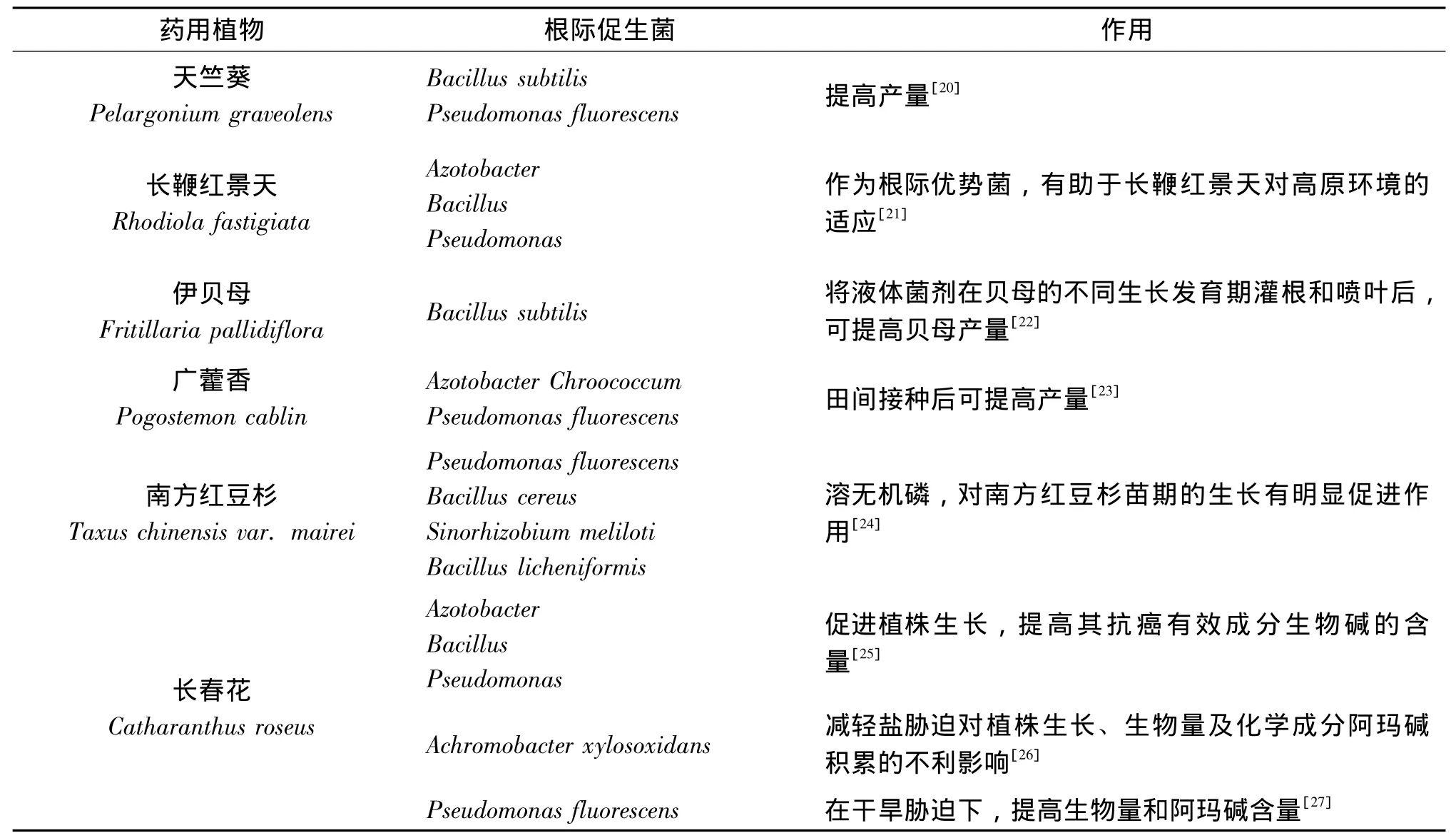根际促生菌研究进展及其在药用植物上的应用*
张智慧,赵振玲,金 航,张金渝,杨天梅,李凌飞
(1.云南省农业科学院药用植物研究所,云南昆明 650231;2.云南农业大学食品科学技术学院,云南昆明 650201)
当代根际微生态系统理论认为根际是植物、土壤和微生物相互作用的重要界面,也是物质和能量交换的结点,而根际微生物正是根际微生态系统的重要组成部分。根际微生物区系主要以细菌为主,能够促进植物生长、防治病害、增加作物产量的有益微生物被称为根际促生菌 (plant growth-promoting rhizobacteria,PGPR)。PGPR种类繁多,广泛存在于植物根系中,可以提高许多农作物的产量[1-5];抑 制 植 物 病 原 菌[6-8]; 改 良 土 壤 结构[9-10];对受重金属污染的土壤也具有一定的修复能力[11]等。
鉴于PGPR存在的普遍性和对植物生长的特殊作用,以及药用植物在人类生活中的重要性,药用植物的PGPR研究受到国内外研究学者的广泛关注。分离和筛选药用植物的PGPR,研究PGPR对药用植物生长和主要有效成分的影响,以及对病原菌的抑制作用,探讨PGPR对中药材道地性的影响机制,对实现中药材产量和质量的稳定可控具有重要的理论和实践意义。本文介绍了PGPR的研究进展,以及PGPR在药用植物领域的研究成果,并探讨了PGPR在药用植物栽培中的应用,以期为中药材规范化种植研究提供参考。
1 PGPR的研究进展
1.1 对植物生长的促进作用
1.1.1 固氮、解磷作用
PGPR可将空气中的分子氮转化为有机氮,供自身和植物利用,改善植物的氮素营养,从而促进植物生长。已经发现的具有固氮作用的PGPR有Azorhizobium、Azotobacter、Bacillus和Rhizobium等属[12-13]。另外,土壤中存在大量难以被植物直接吸收利用的磷,而在植物根际普遍存在能溶磷和解磷的细菌,包括Enterobacter、Nitrobacter、Pseudomonas和Serratia等属[8,13-14],它们通过释放大量有机酸或磷酸酶,溶解无机磷或降解有机磷,从而加速土壤中无效磷的有效化,以利于植物对磷的吸收和利用。
1.1.2 调节植物激素水平
PGPR可以通过调节植物激素 (生长素、细胞分裂素、赤霉素和乙烯)水平来促进植物的生长发育。吲哚乙酸 (IAA)是与植物相关细菌产生的、研究最广泛的植物激素,IAA产生细菌主要包括Azospirillumbrasilense、Aerorrvonas veronii、Comamonas acidovorans、和Rhizobium leguminosarum等种[8]。此外,某些PGPR可以通过产生1-羧基-1-氨基环丙烷 (1-aminocyclopropane-1-carboxylate deaminase,ACC)脱氨酶将植物乙烯的合成前体ACC分解成为丁酮酸和氨,从而抑制乙烯的生成,促进植物快速生长发育,提高抗逆性[15]。Achromobacter、Agrobacterium、Bacillus、 和Burkholderia等属的细菌均具有 ACC脱氨酶活性[8,15]。
1.1.3 产生挥发性有机化合物 (volatile organic compounds,VOCs)
PGPR还可以通过产生VOCs来促进植物生长。Ryu等研究发现,一些PGPR释放出一种混合VOCs,特别是2,3 -丁二醇 (2,3-butanediol)和3-羟基-2-丁酮 (acetoin),能促进拟南芥的生长,并且证实PGPR产生的VOCs是一种调控植物与微生物相互作用的信号分子,当VOCs积累到一定浓度时就可触发植物的生长反应[16]。
1.2 PGPR的生物防治作用
1.2.1 分泌抗生素
许多PGPR可以合成抗生素抑制周围其它微生物的繁衍。已经分离检测到由PGPR产生的抗生素有吩嗪 (phenazines)、藤黄绿脓菌素 (pyoluteorin)、硝吡咯菌素 (pyrrolnitrin)、2,4-二乙酰藤黄酚 (2,4-diacetylphloroglulinol)、粘液菌素酰胺(viscosinamide)和张力蛋白 (tensin)等,这些物质都可在很大程度上抑制各种病原真菌[8]。
1.2.2 与病原菌或有害微生物竞争营养和空间
PGPR可以抢先占据植物根际营养丰富的有利位点,从而阻止和降低了病原菌或有害微生物在这些位点的生存和繁衍,其中最典型是铁竞争。PGPR通过分泌对Fe3+具有高亲和力的铁载体 (siderophore),形成的Fe3+载体复合物,该复合物不能被大多数微生物尤其是病原微生物所利用,使得病原菌生存所需的铁很快耗尽,从而使病原菌繁衍和侵染能力下降。而PGPR和植物可以吸收利用Fe3+载体复合物,所以不会受缺铁的影响[8]。
1.2.3 诱导系统抗性 (induced systemic resistance,ISR)
ISR是指由非致病菌 (主要是有益微生物,细菌和真菌等)诱导植物产生系统抗病性,它与茉莉酸和乙烯的形成积累有密切联系[7,17]。近年来,PGPR诱导植物产生ISR的研究日益增多,主要集中在 Pseudomonas和 Bacillus两个属的细菌上[18]。在菜豆、萝卜、番茄、甘蔗、玉米和水稻等农作物上均发现了此类诱导[7,19]。
2 PGPR在药用植物上的研究状况
国内外研究者对PGPR在药用植物上的研究越来越多,部分研究结果见表1。他们发现接种PGPR不仅可以促进药用植物的生长,增加产量,还可以提高其有效成分的含量,这类研究无疑对稳定药用植物入药质量、寻找新药而言具有重要意义。此外,PGPR还可以作为某些药用植物的生防菌。利用拮抗细菌来防治药用植物的病害,不仅能克服使用农药带来的环境污染,避免农药造成的病原菌产生抗药性等问题,还能最大程度地保证药用植物使用的安全性。

表1 PGPR在药用植物上的相关研究成果

续表
3 PGPR在药用植物栽培上的应用探讨
3.1 PGPR在防治药用植物连作障碍上的应用
近几年来药用植物连作障碍问题日益突出,严重危害着药用植物的正常生长发育和药材品质。土壤理化性质劣变和土壤微生物结构变化是连作障碍产生的重要原因之一,研究发现连作会导致土壤微生物组成显著变化,微生物总数及细菌总数显著减少[40]。目前,尚无绿色环保的方法可以有效缓解和解决连作障碍问题。而PGPR不仅可以改善土壤理化性质,还具有提高植物对养分的吸收、抑制病原菌和诱导系统抗性等作用。由此可见,随着对PGPR和连作障碍有关问题的不断深入研究,利用接种PGPR并结合其它有效措施来克服连作障碍,提高药用植物品质将具有十分巨大的潜力。
3.2 PGPR作为生物肥在药用植物栽培中的应用
为了满足植物生存、生长所需的N、P等营养元素,施用工业化肥一直被认为是增产的主要途径。然而,随着化肥使用量的增加,出现了过度施肥,导致肥效下降、利用率降低等现象。同时生产化肥成本高,非再生能源消耗量大,污染空气、土壤及水质,危害食品安全,破坏土壤结构及微生物区系和多样性等。无疑,PGPR作为一种生物肥,其使用可以从一定程度缓解或避免以上的问题。在欧洲和非洲,人们已经成功地将固氮菌 (Azospirillum)应用在了很多作物上[41]。随着植物根际生态系统,特别是根际微生物相互作用等方面研究不断拓展和深入,相信会有越来越多的PGPR作为生物肥被成功应用。
4 结语
PGPR具有促进药用植物的生长,增加植株对矿质养分N、P、K等元素的吸收,提高药用植物有效成分的含量,增强药用植物的抗环境胁迫能力和抗病性等作用。而栽培药用植物往往出现生长发育不良,病虫害严重,乱施化肥、使用农药造成的质量不稳定、农残超标,连作造成的产量、质量下降等问题,严重威胁了入药的安全性、稳定性、有效性。为此,我们可以借鉴农作物PGPR研究的成果,研究PGPR对药用植物病害的防治作用,药用植物不同生长发育时期PGPR的种群结构的动态变化规律,以及道地药材与非道地药材PGPR种群结构的差异,同时将这些差异与药材性状、产量和有效成分等方面结合起来,从根际微生态环境的角度揭示道地药材的科学内涵,为中药材规范化种植提供技术支撑,以期达到提高药用植物质量、增加产量,满足人们用药需要的目的。
[1] Akbari P,Ghalavand A,Modares Sanavy A M,et al.Comparison of different nutritional levels and the effect of plant growth promoting rhizobacteria(PGPR)on the grain yield and quality of sunflower[J].A J C S,2011,5(12):1570-1576.
[2] Ashrafuzzaman M,Hossen FA,Ismail M R,et al.Efficiency of plant growth-promoting rhizobacteria(PGPR)for the enhancement of rice growth[J].Afr J Biotechnol,2009,8(7):1247-1252.
[3] Gerrnida J J,walley F L.Plant growth - promoting rhizobacteria alter rooting patterns and arbuscular mycorrhizal fungi colonization of field-grown spring wheat[J].Biol Fertil Soils,1996,23(2):113 -120.
[4] Malleswari D,Bagyanarayana G.Effect of plant growth promoting rhizobacteria on seed germination and vigor index of sorghum,maize and green gram[J].J Mycol Pl Pathol,2011,41(1):104 -110.
[5] Datta M,Palit R,Sengupta C,et al.Plant growth promoting rhizobacteria enhance growth and yield of chilli(Capsicum annuumL.)under field conditions[J].A J C S,2011,5(5):531-536.
[6]康贻军,沈敏,王欢莉,等.两株植物根际促生菌对番茄青枯病的生物防治效果评价[J].中国生物防治学报,2012,28(2):255-261.
[7]Jankiewicz U,Koltonowicz M.The involvement of Pseudomonas bacteria in induced systemic resistance in plants(review)[J].Appl Biochem and Microbiol,2012,48(3):244-249.
[8] Bhattacharyya P N,Jha D K.Plant growth-promoting rhizobacteria(PGPR):emergence in agriculture[J].World J Microbiol Biotechnol,2012,28:1327 -1350.
[9] Sharafzadeh S,Ordookhani K.Organic and bio fertilizers as a good substitute for inorganic fertilizers in medicinal plants farming[J].Aust J Basic&Appl Sci,2011,5(12):1330-1333.
[10] Adesemoye A O,Torbert H A,Kloepper J W.Plant growth-promoting rhizobacteria allow reduced application rates of chemical fertilizers[J].Microb Ecol,2009,58:921-929.
[11] Khan M S,Zaidi A,Wani P A,et al.Role of plant growth promoting rhizobacteria in the remediation of metal contaminated soils[J].Environ Chem Lett,2009,7(1):1-19.
[12] Hayat R,Ali S,Amara U,et al.Soil beneficial bacteria and their role in plant growth promotion:a review[J].Ann Microbiol,2010,60(4):579 -598.
[13] Kevin Vessey J.Plant growth promoting rhizobacteria as biofertilizers[J].Plant Soil,2003,255:571 -586.
[14] Ibiene A A,Agogbua J U,Okonko I O,et al.Plant growth promoting rhizobacteria(PGPR)as biofertilizer:Effect on growth ofLycopersicum esculentus[J].AM J SCI,2012,8(2):318 -324.
[15] Kang B G,Kim W T,Yun H S,et al.Use of plant growth-promoting rhizobacteria to control stress responses of plant roots[J].Plant Biotechnol Rep,2010,4:179-183.
[16] Ryu C M,Farag M A,Hu C H,et al.Bacterial volatiles promote growth in Arabidopsis[J].P N A S,2003,100(8):4927-4932.
[17] Kloepper J W,Tuzun S,Kuc J A.Proposed definitions related to induced disease resistance[J].Biocon SciTechnol,1992,2(4):349 -351.
[18] Choudhary D K,Prakash A,Johri B N.Induced systemic resistance(ISR)in plants:mechanism of action[J].Indian J Microbiol,2007,47:289 -297.
[19] Viswanathan P,Samiyappan R.Induction of systemic resistance by plant growth promoting rhizobacteria against red rot disease in sugarcane[J].Sugar Tech,1999,1:67-76.
[20] Mishral R K,Prakash O,Alam M,et al.Influence of plant growth promoting rhizobacteria(PGPR)on the productivity ofPelargonium graveolensL.Herit[J].Rec Res Sci Tech,2010,2(5):53-57.
[21]张新军,郑维列,兰小中,等.色季拉山长鞭红景天根际微生物初步研究[J].中国农学通报,2011,27(28):172-177.
[22]潘惠霞,程争鸣,齐晓玲,等.伊贝母根际有益微生物对栽培产量的影响[J].干旱区地理,2010,33(6):917-922.
[23] Singh R,Divya S,Awasthi A,et al.Technology for efficient and successful delivery of vermicompost colonized bioinoculants inPogostemon cablin(patchouli)Benth.[J].World J Microbiol Biotechnol,2012,28(1):323-333.
[24]任嘉红,刘辉,吴晓蕙,等.南方红豆杉根际溶无机磷细菌的筛选、鉴定及其促生效果[J].微生物学报,2012,52(3):295-303.
[25] Karthikeyan B,Joe M M,Jaleel C A,et al.Effect of root inoculation with plant growth promoting rhizobacteria(PGPR)on plant growth alkaloid content and nutrient control ofcatharanthus roseus(L.)G.Don[J].Nat Croat,2010,19(1):205 -212.
[26] Karthikeyan B,Joe M M,Islam M R,et al.ACC deaminase containing diazotrophic endophytic bacteria ameliorate salt stress inCatharanthus roseusthrough reduced ethylene levels and induction of antioxidative defense systems[J].Symbiosis,2012,56:77 -86.
[27] Jaleel C A,Manivannan P,Sankar B,et al.Pseudomonas fluorescens enhances biomass yield and ajmalicine production inCatharanthus roseusunder water deficit stress[J].Colloids Surf,B,2007,60:7 -11.
[28] Selvaraj T,Sumithra P.Effect ofGlomus aggregatumand plant growth promoting rhizomicroorganisms on growth,nutrition and content of secondary metabolites inGlycyrrhiza glabraL.[J].Indian J Applied&Pure Bio,2011,26(2):283-290.
[29] Khalesro S H,Ghalavand A,Sefidkon F,et al.The effect of biological and organic inputs on quantity and quality of essential oil and some elements content of anise(Pimpinella anisumL.)[J].Iranian Journal of Medicinal and Aromatic Plants,2012,27(4(54)):551 -560.
[30] Ordookhani K.Investigation of PGPR on antioxidant activity of essential oil and microelement contents of sweet basil[J].Adv Environ Biol,2011,5(6):1114 -1119.
[31] Golpayegani A,Tilebeni H G.Effect of biological fertilizers on biochemical and physiological parameters of basil(Ociumum basilicmL.)medicine plant[J].American-Eurasian J Agric&Environ Sci,2011,11(3):411-416.
[32] Gupta M,Bisht S,Singh B,et al.Enhanced biomass and steviol glycosides inStevia rebaudianatreated with phosphate-solubilizing bacteria and rock phosphate[J].Plant Growth Regul,2011,65(3):449 -457.
[33] Sharaf- Eldin M,Elkholy S,Fernández J A,et al.Bacillus subtilis FZB24®affects flower quantity and quality of saffron(Crocus sativusL.)[J].Planta Med,2008,74(10):1316-1320.
[34]龚凤娟,恩特马克·布拉提白,张宇凤,等.具有ACC脱氨酶活性的杜仲内生细菌的分离鉴定及其抗菌活性[J].微生物学通报,2011,38(10):1526-1532.
[35] Srimathi L P,Kumutha K.Growth and alkaloid yield ofColeus forskohliiwith the inoculation of arbuscular mycorrhiza fungi and plant growth promoting rhizobacteria[J].Mycorrhiza News,2009,21(3):24 -28.
[36] Ramos Solano B,Pereyra de la Iglesia M T,Probanza A,et al.Screening for PGPR to improve growth ofCistus ladaniferseedlings for reforestation of degraded mediterranean ecosystems[J].Plant Soil,2006,287:59 -68.
[37]杨娜,沈其荣,徐阳春.一株抗药用白菊枯萎病生防菌的分离与生防效应研究[J].植物营养与肥料学报,2011,17(3):731-736.
[38]姜竹,李晶,王玉霞,等.人参土传病害生防菌株的筛选及抑菌活性研究[J].安徽农业科学,2011,39(11):6464-6466.
[39] Cho K M,Hong SY,Lee SM,et al.Endophytic bacterial communities in ginseng and their antifungal activity against pathogens[J].Microbial Ecology,2007,54:341-351.
[40]张子龙,王文全.植物连作障碍的形成机制及其调控技术研究进展[J].生物学杂志,2010,27(5):70-72.
[41] Vessey J K.Plant growth promoting rhizobacteria as biofertilizers[J].Plant Soil,2003,255:571 -586.

